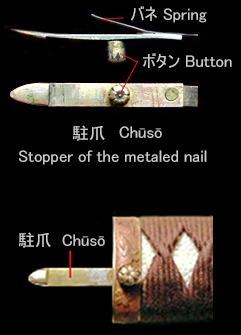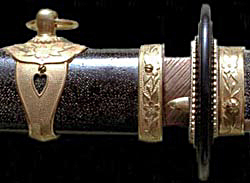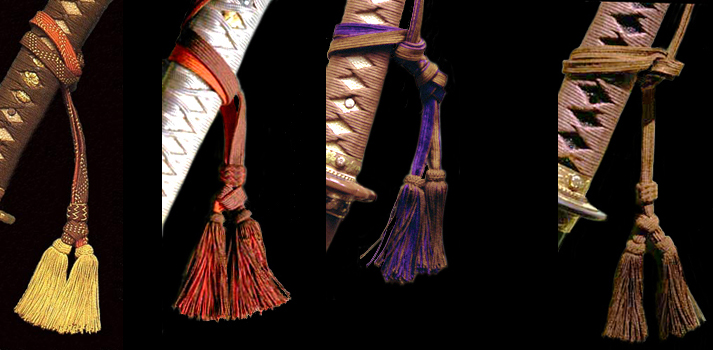Military Swords of
Imperial Japan
Scabbard, Spring clip and Tassel for
new Guntōes
Changes and the kind of Saya of a new
Guntō
Introductory notes: Scabbard =
Saya
Army Type 94 Guntō:
The quality of the material is steel (an inner scabbard Saya is a
magnolia), and the coating
color was specified as bluish blackish brown. There is much
gloss coating.
Army Type 98 Guntō:
The quality of the material is steel (an inner scabbard Saya is a
magnolia), and the coating
color was specified as bluish blackish brown. It is the same
as Type 94 Gunto.
However, the quality of the material changed with the iron →
aluminum → leather cover wooden
scabbard by change of the conditions of a country. The quality
of the Saya deteriorated gradually.
The early type was on
extension of the Type 94 Gunto Saya paint. There is also gloss coating
of "a
vermilion
system and a green system" besides a standard coating color.
Usually, although there is much semigloss coating of "khaki
and a brown system", since it is an
officer's personal belongings, the coating color of a Saya is
various.
Army Type 3 Guntō: Compared
with the Type 94 and 98, it became the Koshirae of a function and
practicality serious
consideration.
The Kuchi-gane of protection-against-dust 2 division was
adopted. Semegane which was an ornament was
omitted in the iron Saya. The Saya of a Type 3 improved
markedly compared quality and the strength of
the informality Koshirae of a Type 98, .The Type 3 became the
last formal Gunto in an imperial army.
Metallic ornaments change delicately with production
companies. There are a normalized form and a last
stage
type.
Navy Type Tachi: An iron
Saya is not used from consideration of marine damage from salt water.
It is a standard to
wind the Same skin around a wooden Saya. There are also
lacquered and paint coating.
A navy Guntō has few manufactures and there is no fall of the Koshirae
grace like an army.
Army Type 94 Guntō's Saya

Bluish blackish brown (standard color)
|

Blackish brown
|

Vermilion
|

Brown rayskin binding
wooden Saya
|
Army Type 98 Guntō's Saya
Navy Type Tachi's Saya

Black rayskin binding wooden Saya
|
Black lacquered wooden Saya |

Brown rayskin binding wooden Saya |
Wooden Saya of red
sandalwood color coating
|
Army Type
3 Guntō's Saya

Iron scabbard: black semigloss uneven coating.
|
Wooden scabbard: Reddish brown semigloss uneven
coating.
|
Army
Type 94
The second Haikan of the Types 94 is an
attachment-and-detachment Type. It equipped, when hanging on the
formal sword belt of courtesy, and it usually removed, and was
hanging by one Haikan on theinformal sword belt.
Since the Type 98 revised the actual condition, both do not have
a fundamental difference as a Gunto Koshirae.
Desorption type (There are three systems by
a production ompany)

Fixed type Desorption Type
When a desorption Type Haikan is removed,it is the same as Types 98.

Blade-Clip
Introductory notes: metaled
nail =
Chūsō
In order for a blade to prevent deviating from a Saya carelessly,
there are three sorts of methods of stopping a blade.
(1) The stop by the
Habaki (Habaki-dome type): This is a
method from ancient times. This method uses the
frictional resistance of the Habaki and a wooden
scabbard (Saya).
A Tachi and a Uchigatana are this method all.
(2) The stop by the
metaled nail (Chūsō-type)
(3) The stop by the
button of a leather bunt
(2) and (3) are the peculiar stopping method for the Guntō.
The Type 94 and the Type 98 first stage type is a stop by the
metaled
nail.
The Type 98 middle type are intermingled stop by the metaled
nail or the stop by a Habaki.
An informal leather cover wooden scabbard
is the stop by the button of a leather bunt or the stop by a Habaki.
A
Type 3 is the stop by the metaled nail.
A navy Type Tachi has many traditional stop by a Habaki, and
there is few stop by the metaled nail.
This is considered because a naval Guntō view and the
environment of use differ from an army
considerably.
By
the metaled nail (Chūsō-type)
Type
94, 98 and Tachi
The position of the
Chūsō has two sorts a center and lower parts. The Chūsō differ
altogether in a work company.
The length of a
Chūsō is adjusted to the thickness of the sum
total of a guard (Tsuba) and a washers for every sword.
Therefore, appropriation of easy parts cannot be performed.
Type
3
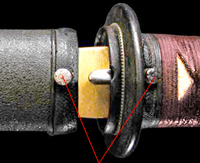
駐爪ボタン
Chūsō-button
A Type 3 has the button of which a Chūsō
is canceled in two places
Type 98 informality mounting
(Wooden leather cover Saya)
The stop by the button of
a leather strap
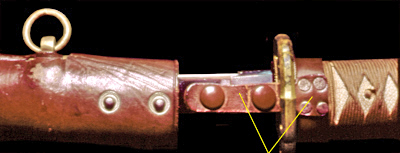
The leather strap around the Fuchi
|
Belt stop
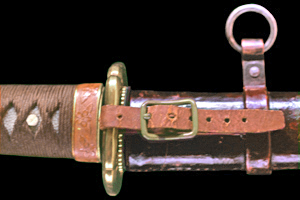
Scabbard leather strap
|
The leather strap united with the Seppa
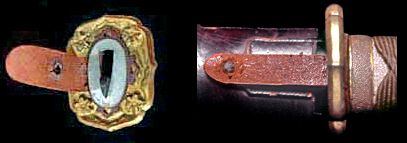

Tassel
& Class
A tassel displays an officer's class. It uses for the
reinforcement (it twists around a right wrist) when extracting a sword
and grasping a Tsuka.
The role of a tassel is as variegated as an ornament and
practical use.
It is an element indispensable to a Gunto Koshirae.
An army tassel;
Plain weave (Kōrai textile): A surface color is "brown".
In the back, a color changes with an officer's classes.
General: Red (it is embroidery zigzag about gold
thread to a table and the reverse side) and a fringe is
gold thread.
Field
officer: Red. The thread of a fringe is brown and red.
Company
officer: Blue. The thread of a fringe is as blue as brown.
Navy tassel: Plain
weave (Kōrai textile): A table and the reverse side are "brown".
There is no discrimination by an officer's class.
A tassel displays an officer's
class
General
Field officer Company
officer Naval
officer Common
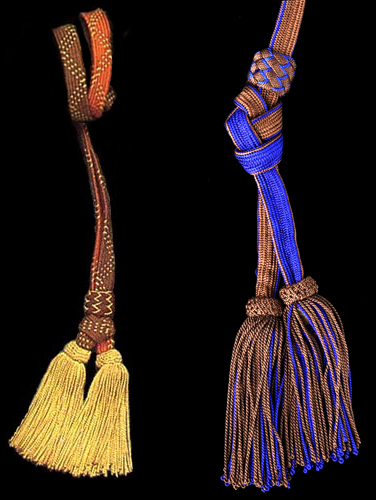
|
← A tassel has two sorts, ordinary
quality and the good quality which
bordered the both ends of a tassel
with opposite thread.
There is two kinds of how to tie
regardless of quality. →
|

How to tie a tassel and quality
Left: Good quality
Right: Ordinary quality
|
November 26, 2013 
To the top of a page ▲























